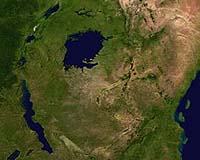| . |  |
. |
Cambridge MA (SPX) Jan 26, 2010 Harvard climate scientists suggest that the Tibetan Plateau-thought to be the primary source of heat that drives the South Asian monsoon-may have far less of an effect than the Himalayas and other surrounding mountains. As the monsoon brings needed rainfall and water to billions of people each year, understanding its proper origin, especially in the context of global climate change, is crucial for the future sustainability of the region. The researchers say the their findings, published in the January 14th issue of Nature, have broad implications for how the Asian climate may have responded to mountain uplift in the past, and for how it might respond to surface changes in the coming decades. Often called the "roof of the world," the Tibetan Plateau is a vast area of 2.5 million square kilometers with an average elevation of more than 4,500 meters. Scientists have long theorized that the massive release of heat from the surface of the plateau-with air being heated to higher temperatures over the plateau than air at the same height over lower-level surfaces nearby-has been a major contributor to the strength of the monsoon. "The South Asian monsoon supplies water to billions of people, many of whom live in developing nations and agricultural societies that are highly vulnerable to variations in this water supply," explains co-author Zhiming Kuang, Assistant Professor of Climate Science in Harvard's School of Engineering and Applied Sciences (SEAS) and Department of Earth and Planetary Sciences (EPS). While the heating by the plateau does enhance rainfall along its southern edge, Kuang and his colleague William Boos, Daly Postdoctoral Fellow in EPS and an environmental fellow at the Harvard University Center for the Environment (HUCE), used an atmospheric circulation model to show that the large-scale South Asian summer monsoon circulation remains unaffected when the plateau is removed. It turns out that the narrow geography of the Himalayas and other nearby mountain ranges can, in fact, produce an equally strong monsoon by insulating warm, moist air over continental India from the cold dry extratropics, the area between the subtropics and polar regions. "Because heat from the plateau has been seen as the main contributor to the power of the monsoon, much attention has been given to changes in the plateau's albedo, or its reflectivity level of the sun's radiation," says Kuang. For example, a decrease in snow cover over the Tibetan Plateau resulting from an increase in global temperatures can affect reflectivity, and hence, the level of heat. The revised theory, emphasizing the important role the mountains play in trapping warm and moist air, suggests that climate scientists should pay as much attention to changes over the Indian subcontinent due to, for example, land use. How the region's natural environment is modified through activities such as building, mining, and agriculture, Zhang explains, can influence albedo and moisture, thus altering the temperature/humidity of the boundary layer air. By considering the influence of both the plateau and the mountains on the strength of the monsoon, the Harvard researchers expect a clearer picture will emerge about the potential changes in the South Asian water supply in the coming decades. "Ultimately, our revised view has implications for future projections of how the South Asian monsoon might be altered in a warmer world and can be used to infer aspects about the earth's climate history," says Boos.
Share This Article With Planet Earth
Related Links Harvard University Water News - Science, Technology and Politics
 Beijing promises 'constructive' role in African Great Lakes
Beijing promises 'constructive' role in African Great LakesKigali (AFP) Jan 27, 2010 Senior Chinese official Zhai Jun told Rwanda's President Paul Kagame in talks here that Beijing is ready to play a wider role in regional security, Radio Rwanda reported Wednesday. "As a permanent member of the UN security council, China is ready to play a constructive role in promoting sustainable stability and security in the Great Lakes region," said Zhai, an assistant foreign minister. ... read more |
|
| The content herein, unless otherwise known to be public domain, are Copyright 1995-2009 - SpaceDaily. AFP and UPI Wire Stories are copyright Agence France-Presse and United Press International. ESA Portal Reports are copyright European Space Agency. All NASA sourced material is public domain. Additional copyrights may apply in whole or part to other bona fide parties. Advertising does not imply endorsement,agreement or approval of any opinions, statements or information provided by SpaceDaily on any Web page published or hosted by SpaceDaily. Privacy Statement |